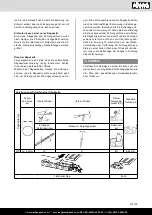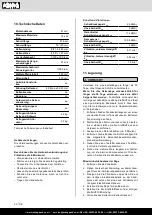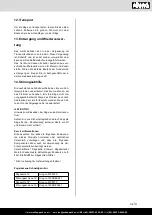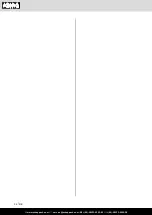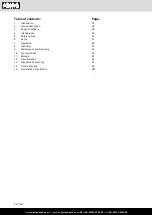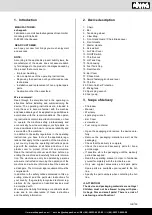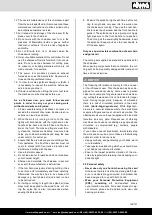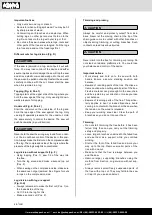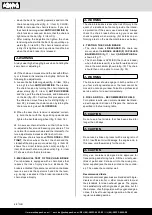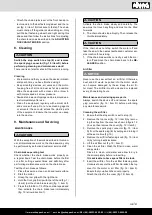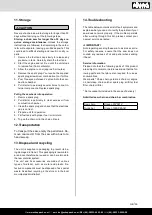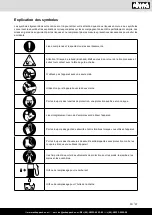
www.scheppach.com /
+(49)-08223-4002-99 /
+(49)-08223-4002-58
GB | 43
Causes and prevention of kickback:
•
Kickback can occur when the tip of the guide bar
touches an object or when the timber bends and
the saw-chain becomes caught in the cut.
• Contact with the guide bar tip can, in some cas-
es, lead to an unexpected backwards reaction in
which the guide bar is thrown up and in the direc-
tion of the operator.
• If the saw-chain becomes caught at the top of the
guide bar, the guide bar can quickly kick back to
-
wards the operator.
•
Each of these reactions can cause you to lose con
-
trol over the saw and potentially to get severely in
-
jured. Do not exclusively trust the safety devices
built into the chainsaw. As the user of a chainsaw,
you should take different measures to work acci
-
dent and injury free.
Kickback is the consequence of incorrect or erratic
use of the machine. It can be prevented by appropri
-
ate safety measures such as described below:
• Hold the saw with both hands, ensuring
thumbs and fingers clasp the handles of the
chainsaw. Position your body and arms in such
a way that you can withstand kickback forces.
If appropriate measures are taken, the operator
can control kickback forces. Never let go of the
chainsaw.
• Avoid an abnormal body posture and do not
saw above shoulder height.
This prevents ac-
cidental contact with the tip of the guide bar and
it enables better control of the chainsaw in unex-
pected situations.
• Always use replacement guide bars and saw-
chains specified by the manufacturer.
Incorrect
replacement guide bars and saw-chains can cause
breaking of the chain and/or kickback.
•
Follow the manufacturer‘s instructions con
-
cerning sharpening and maintenance of the
saw-chain.
Over-reduction of depth limiters in-
creases kickback tendency.
m
WARNING
Note the following:
•
Rotational kick-back (fig. 28)
A = kick-back distance / B = kick-back reaction
zone
•
Kick-back and kick-back reactions when there is
an impact/blockage (fig. 29)
A = pull / B = fixed objects / C = press
• In order to prevent kick-back reactions, position
the wood to be sawn directly at the claw stop. Use
the claw stop as the rotation point when sawing.
11 THE THROTTLE TRIGGER INTERLOCK
pre-
vents accidental acceleration of the motor. The throt-
tle can be activated only when the throttle trigger in
-
terlock is pressed.
10 THE ON/OFF SWITCH
immediately stops the mo
-
tor when it is switched off. The stop switch must be
turned to ON to start the motor (again).
16 CHAIN PROTECTOR
applied when the motor is
at a standstill and prevents the risk of cutting injuries
due to the chain teeth.
20 THE CHAIN CATCHER
reduces the risk of inju-
ry if the saw-chain breaks or slips when the motor
is running. The chain catcher is designed to catch a
flailing chain.
m
NOTICE
Familiarise yourself with the saw and its components.
5.5 Warning notices for chainsaws
• When the saw is running, keep all body parts
away from the saw-chain. Before starting the
saw, ensure that nothing touches the saw-
chain.
When working with a chainsaw, a moment
of carelessness can cause clothing or body parts
to be caught by the saw-chain.
• Do not work with this chainsaw on a tree un-
less you are especially trained for this.
In the
event of improper use of a chainsaw on a tree,
there is a risk of injury.
• When cutting a branch under tension, expect
it to spring back.
When the tension is released,
the branch can hit the operator and/or take away
control of the chainsaw.
•
Be particularly careful when cutting under
-
growth and young trees.
Thin material can get
caught in the saw-chain and be ejected in your di
-
rection or make you lose your balance.
•
Carry the chainsaw by the front handle with the
saw-chain not moving and the guide bar point-
ing backwards. During transport and storage
of the chainsaw always attach the safety cov
-
er.
Careful handling of the chainsaw reduces the
likelihood of accidentally touching the running saw-
chain.
•
Follow the instructions for lubrication, chain
tension and replacement of accessories.
An im-
properly tensioned or lubricated chain can either
break or increase the kickback risk.
•
Keep handles dry, clean and free from oil and
grease.
Greasy, oily handles are slippery and
cause loss of control.
Содержание 5910113903
Страница 6: ...www scheppach com service scheppach com 49 08223 4002 99 49 08223 4002 58 6 26 5 27 28 29 30...
Страница 33: ...www scheppach com service scheppach com 49 08223 4002 99 49 08223 4002 58 DE 33...
Страница 34: ...www scheppach com service scheppach com 49 08223 4002 99 49 08223 4002 58 34 DE...
Страница 37: ...www scheppach com service scheppach com 49 08223 4002 99 49 08223 4002 58 GB 37 Start Stop manual Mixing ratio...
Страница 134: ...www scheppach com service scheppach com 49 08223 4002 99 49 08223 4002 58 134 NL Start Stop hendel Mengverhouding...
Страница 159: ...www scheppach com service scheppach com 49 08223 4002 99 49 08223 4002 58 PL 159 D wignia Start Stop Stosunek mieszania...
Страница 207: ...www scheppach com service scheppach com 49 08223 4002 99 49 08223 4002 58 HU 207 Ind t Le ll t kar Kever si ar ny...
Страница 231: ...www scheppach com service scheppach com 49 08223 4002 99 49 08223 4002 58 SK 231 P ka tart stop Mie ac pomer...
Страница 251: ...www scheppach com service scheppach com 49 08223 4002 99 49 08223 4002 58 251...

